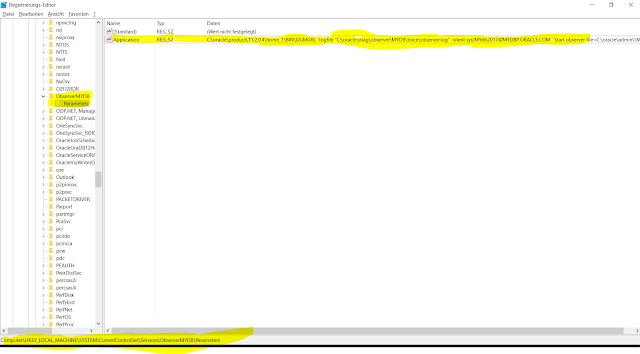How to Configure Observer and Enable Fast Start Failover for Oracle Dataguard
1. HSTART ( Hidden Start ) software (keep in mind its not free)
2. SilentCMD (its free)
3. Windows task Scheduler.
Lets pick up the easiest way and quickly configure Observer on Windows without wasting much time. I am not going to use any of the 3 listed above rather keeping it more easy.
Advice :- There are lots of Parameter (Variables) and Values used in this post are specific to my Test Environment. Please Change them as per your Environment. Also while you are changing these please be very careful and avoid any typo etc otherwise your Observer will not start.
I am assuming that you have already installed Oracle binaries if not then its time to install.
Step2: Configure TNS Entries
2. Make sure your Primary and Standby database is reachable from Observer Server and TNSNAMES.ORA has entry for both Primary and Standby. Ensure TNSPING is working for both from Observer Server
MYDBP.ORACLE.COM =
(DESCRIPTION =
(ADDRESS_LIST =
(ADDRESS = (PROTOCOL = TCP)(HOST = prod.oracle.com)(PORT = 1521))
)
(CONNECT_DATA =
(SERVICE_NAME = MYDB)
)
)
MYDBS.ORACLE.COM =
(DESCRIPTION =
(ADDRESS_LIST =
(ADDRESS = (PROTOCOL = TCP)(HOST = stdby.oracle.com)(PORT = 1521))
)
(CONNECT_DATA =
(SERVICE_NAME = MYDB)
)
)
Step3: Create Directory Structure
On observer Server create following directories.
mkdir C:\oracle\diag\observer\\trace\
mkdir C:\oracle\admin\\
Note:- Adjust the path as per your Environment
Below exe is available as part of Resource Kit Tools and can be downloaded from HERE
Copy both the exe's instsrv.exe and srvany.exe in C:\windows\system32
instsrv.exe to C:\windows\system32
srvany.exe to C:\windows\system32
Note :- instrsrv.exe is used to install the service while srvany.exe acts as a wrapper around the application and handles the service events. Both utilities are available as part of Microsoft’s Windows Server 2003 Resource Kit Tools. For more information on this visit
Step5: Create Windows Service
Create a windows service for your Observer
cd C:\WINDOWS\system32
sc create ObserverMYDB binPath= C:\Windows\System32\srvany.exe DisplayName= "ObserverMYDB" (replace ObserverMYDB as you Need)
Step6: Create Registry Entry
Create a Windows registry entry for your application
create file edit_reg_for_observer.reg with following contents. Please pay attention to the file extension. Please adjust the following as per your environment.
ORACLE_HOME
ORACLE_SID
TNS_CONNECT
PASSWORD
Windows Registry Editor Version 5.00
[HKEY_LOCAL_MACHINE\SYSTEM\CurrentControlSet\Services\ObserverMYDB\Parameters]
"Application"="C:\\oracle\\product\\11.2.0.4\\home_1\\BIN\\DGMGRL -logfile "C:\\oracle\\diag\\observer\\MYDB\\trace\\observer.log" -silent sys/XXX@MYDBP.ORACLE.COM \"start observe\""
Step7: Update Registry
Double click on edit_reg_for_observer.reg. This will create a registry entry for your Observer.
Step8: Create Registry Entry "Application"
Navigate in regedit to Parameters (HKEY_LOCAL_MACHINE\SYSTEM\CurrentControlSet\Services\ObserverMYDB\Parameters) right click and create new String Value called ‘Application’ and set following value.
C:\oracle\product\11.2.0.4\home_1\BIN\DGMGRL -logfile "C:\oracle\diag\observer\MYDB\trace\observer.log" -silent sys/xxxx@MYDBP.ORACLE.COM "start observer file=C:\oracle\admin\\MYDBP\fsfo.dat"
Step9: Start Observer Service
Start the Service ObserverMYDB.
open command prompt (cmd)
type services.msc
locate Service ObserverMYDB
right click
go to properties and change startuptype from Manual to Automatic
Right click on the service and start.
Step10: Verify Logfiles
Check the observer logfile and Configuration file
C:\oracle\diag\observer\MYDB\trace\observer.log
C:\oracle\admin\\MYDBP\fsfo.dat
And you are done with Observer Setup.
Go to Primary Database. use dgmgrl utility and enable fast_start_failover.

Comments
Post a Comment